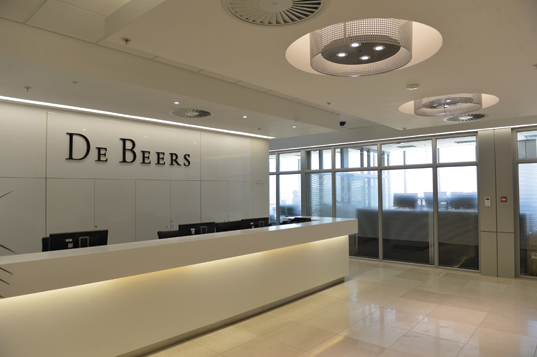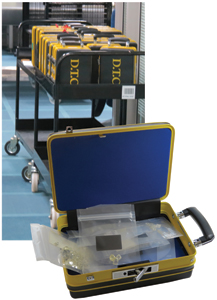|
Industry
A More Accessible De Beers
De Beers is working to be more accessible to its clients, and the industry at large, since moving its sights from London to Gaborone, Botswana, one year ago.
By Avi Krawitz

|
| De Beers Global Sightholder Sales office in Gaborone. Photo courtesy De Beers. |
Upon arriving at Gaborone’s Sir Seretse Khama International Airport, travelers are welcomed with the traditional Tswana greeting, “Dumela, Welcome to Botswana.” For sightholders, now quite accustomed to the airport’s arrivals hall — and the relatively long flight to get there — the greeting marks a stark contrast to the gray skies and traffic of London which, until just one year ago, was De Beers long-serving sorting, sales and distribution center.
Conscious of the extended time and more complicated connections and travel arrangements required of sightholders traveling to the more remote southern African center, De Beers has gone out of its way to make Botswana as welcoming as possible. In the process, the company claims to be more available to its clients and the diamond market in general as it attempts to dismiss historical perceptions of its operations.
“We’re taking a much more proactive approach regarding our relationship with customers and the move to Botswana was a catalyst for that change,” says Paul Rowley, executive vice president of De Beers Global Sightholder Sales. “We’re in a very different building that is brighter and lighter, with offices that are designed to be much more open to give that sense of accessibility.”
Rowley adds that the company is spending a lot more time in the market with its clients than before the move to Botswana in order to gain a greater understanding of their needs and consequently add value back into the business. In return, De Beers is demanding that sightholders raise their level of transparency and financial compliance if they wish to retain their supply in the next three-year contract period that begins on April 1, 2015.
The company recently opened the application period for the new sightholder contracts, presenting a far simpler process that does not have the cumbersome, lengthy questionnaires that defined previous application procedures. Rather, applicants must simply comply with international financial reporting standards (IFRS) and the De Beers Best Practice Principles on ethical performance and demonstrate sufficient demand for rough.
While new applicants will have to prove their compliance from the beginning of the application process, De Beers has given some leeway to existing sightholders to ensure they are compliant by 2017. Rowley stresses that the company is looking for customers who are well structured, have good financials and can cope with market volatility. “Part of the reason we changed the contract is we feel that we need to be more robust as an industry,” he explained. “We want to work with companies that can innovate. It’s really about ensuring sustainability for our business.”
In particular, De Beers management argues that financial compliance is necessary for the industry to navigate the changing and increasingly cautious banking environment. Nigel Simson, senior vice president of De Beers Global Sightholder Sales, notes that liquidity has become a major issue for the trade because the banks are reassessing their exposure to the industry. That’s why, he stresses, the industry needs to demonstrate an increased level of transparency and adherence to financial regulations that would make a bank comfortable lending to a new customer.
Philippe Mellier, De Beers chief executive officer (CEO), is urging sightholders to adapt to the changing environment to be more comfortable with uncertainty. Speaking at the annual Business Excellence Seminar at the Jwaneng mine during the August 2014 sight, Mellier said sightholders need to take steps to reduce volatility so that they have the liquidity to invest in technology, infrastructure, manufacturing, design, marketing and new markets that can enable growth. “We need to see emerging changes earlier,” Mellier said. “That will give us the best chance to respond in an effective and timely manner, and take advantage of any opportunities that might arise.”
As part of its own strategy to deal with these challenges, De Beers has become more flexible regarding its client base. In particular, the introduction of the accredited buyer system during the next contract period presents the potential for De Beers to supply more nonsightholder companies. Accredited buyer status will be given to businesses that meet De Beers compliance criteria but do not qualify as sightholders. They’ll have the opportunity to purchase rough from an enlarged pool of so-called ex-plan supply — rough that is made available in excess of sightholders’ annual application for goods, known as their intention to offer (ITO).
Rowley assures that about 90 percent of De Beers supply will still be offered to sightholders, who will be able to protect their market share if they demonstrate consistent demand. The remaining 10 percent will continue to be sold via De Beers Auction Sales. However, Rowley admits that the accredited buyer system provides De Beers with more options for its supply and opens clients up to a more competitive environment.
“If your model is changing and you choose not to buy goods, then that rough is going to be available to others,” Rowley explains. “It’s about competitiveness, but the philosophy of putting the right goods into the right hands remains the same. That’s what we believe will drive our business into the future.”
While De Beers is preaching change to its customers, it has been forced to adapt to significant changes itself in accommodating its closer ties to Botswana while the government tries to leverage its production resource to create a sustainable local diamond industry that is less reliant on mining only (see Botswana’s Diamond Landscape in the Industry section). In particular, the state-owned Okavango Diamond Company (ODC) was established to sell up to 15 percent of local mining company Debswana’s diamond production, which would previously have been sold by De Beers.
ODC adds another level to the Botswana government’s multilayered relationship with De Beers. The government owns a 15 percent stake in De Beers Group, with Anglo American holding the remaining 85 percent. The government and De Beers also have an equal partnership in Debswana as well as in Diamond Trading Company Botswana (DTCB), which, until a year ago, was responsible for sorting Debswana production and selling rough earmarked for local sightholders.
Kago Mmopi, DTCB’s manager of public affairs and corporate communications, explains that DTCB’s role changed with the launch of ODC and the transfer of De Beers international sales to Gaborone. While DTCB no longer sells directly to sightholders, it provides a service of sorting and valuing Debswana production on behalf of its two clients — De Beers Global Sightholder Sales and ODC.
Goods arrive at DTCB on a weekly basis from Debswana’s four mines. Mmopi estimates that it takes about two months to sort five shipments, which make up a sight cycle worth of goods. In total, it takes about three months for rough to move from the ground to the sight box.
Debswana’s run-of-mine production is separated into ODC and De Beers supply and is sorted by DTCB according to the two clients’ respective assortment guidelines, with about 11,500 categories in the De Beers model. DTCB then sends the assortments to the two companies. De Beers Global Sightholder Sales, which is located on the same premises as DTCB, subsequently mixes its Debswana production with supply from its operations in South Africa, Namibia and Canada in a process called aggregation, before preparing its boxes for sightholders.
De Beers Global Sightholder Sales absorbed the DTCB sales team — or so-called key account managers — so that it could sell to both De Beers international clients and the 21 Botswana sightholders in Gaborone. Sightholders with a sight in South Africa and Namibia sightholders receive their supply in their respective locations.

|
| De Beers is planning to replace its old Diamond Trading Company (DTC) boxes with new sight boxes displaying the De Beers brand logo. |
Once De Beers has its supply, the distribution is done much as it was previously. Approximately 80 sightholders travel, or send broker representatives, to Botswana ten times a year for the sights. They generally receive an overall value of their boxes on the Wednesday before sight week and then get more detail on price and volume on the first day of the sight. During sight week, sightholders book a slot to view their supply in one of 20 viewing rooms in the De Beers building, with the sight open each day from 7 a.m. to 7 p.m.
Sightholders collect their boxes, open the seal to view the goods and are allowed to bring in any technology to assist in their valuation of the goods. Once they make their purchase decision, the goods are resealed, the sightholder is invoiced and payment is made before the boxes are sent for delivery. De Beers makes the first shipment on the Tuesday of sight week while the majority of goods are sent out by Thursday. The company does allow for some refusals. One De Beers key account manager explains that sightholders can return up to 10 percent of the carat volume of each box, which is then held in inventory for the next sight. Furthermore, a sightholder can postpone taking a box from one sight to the next but no later, once every half year.
Sightholders are charged additional fees for optional services during the sight and generally pay the De Beers price plus 2.5 percent of the box value for their supply. These fees include the De Beers value service fee, which amounts to 1.5 percent of the box value, and a 1 percent fee paid to brokers that sightholders might work with.
Rowley explains that the value service fee gives De Beers the ability to plan ahead and deliver a more guaranteed and consistent supply to customers. The service provides sightholders the capacity to say when they want to receive the goods, whereas standard sightholders, who opt not to pay the fee, don’t have a firm delivery schedule. A personalized key account manager is also assigned to sightholders.
For De Beers, the service is also a mechanism to better understand its clients, especially how the company’s supply fits into sightholders’ factory operations and business models. Rowley stresses that strengthening De Beers relationship with its customers has been a core strategy for the company in the past year of operating from Botswana. That includes spending more time in the global diamond trading centers and investing more in market intelligence. In addition, the company has restructured its corporate branding with new sight boxes displaying the De Beers logo that will replace the boxes with the DTC logo. The company also recently rolled out its new sightholder signature marketing mechanism with detailed explanations on how sightholders can gain the maximum exposure from their association with De Beers.
With all of these changes and innovations, the diamond industry is being introduced to a new De Beers identity in addition to its physical relocation and adjustment to the way it functions. Rowley adds that the move to Gaborone was a catalyst for change in the way the industry operates, and how it perceives De Beers operations. “We felt that the move to Botswana provided an opportunity to push forward from some of the perceptions of the past in London, which was perhaps a bit dark in general,” he says. “We wanted to open the mood.”
While Gaborone certainly presents a more inconvenient location and longer travel time, sightholders, at least, are saying “Dumela” to the idea of a more accessible De Beers.Article from the Rapaport Magazine - December 2014. To subscribe click here.
|
|